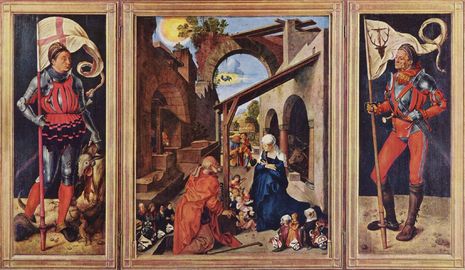Discovering Dürer: the calculated hand of the northern Renaissance
Otto Bajwa-Greenwood reviews Discovering Dürer, the Fitz’s attempt to capture the rich Renaissance legacy of Albrecht Dürer

A revival of classical ideas and new approaches to anatomy, the invention of the printing press, and burgeoning urban trade centres were just a few of the many factors that prompted the unprecedented artistic flourishing of the Italian Renaissance. The work of one of the most celebrated artistic pioneers of this period, Albrecht Dürer (1471-1528), is fortunately being presented at the Fitzwilliam Museum to praise and question the period’s rich legacy. After four years dedicated to restoring its complete collection of 374 Dürer prints, around 50 of his more significant impressions are presented in this free exhibition: Discovering Dürer
As the exhibition outlines, Albrecht Dürer was born in Nuremberg, a nascent humanist and religious centre. From a young age he displayed prodigious artistic talent. His initial training came from his father, a skilled goldsmith, who instilled in him an extraordinary precision and meticulous attention to detail that would define his later work. The exhibition panel notes that Dürer was “the first European artist to establish an international reputation through his ambitious and experimental printmaking.” However, in its brevity, the exhibition omits some of the core details of Dürer’s artistic influences that I think would be valuable in appreciating and further scrutinising his work.
“The exhibition omits some of the core details of Dürer’s artistic influences”
After his apprenticeship in Nuremberg, for example, Dürer embarked on a series of travels that would further deepen his artistic curiosity and entrepreneurial efforts, encouraging the “internationalism” the exhibition points out in paucity. In 1490, he undertook his “Wanderjahre,” a customary journey for young artists to gain experience, for approximately four years. Moreover, his travels also took him to Italy twice, where he encountered the burgeoning Renaissance. The direct exposure to Italian masters like Giovanni Bellini and Andrea Mantegna, along with the indirect influence of Leonardo da Vince and Raphael, broadened Dürer’s artistic horizons. This enabled him to fuse Northern European detail with Italian ideals of grandeur and harmony.
While missing some contextual detail, the prints featured in the Fitz perfectly outline these substantive influences. His woodcuts, like ‘The Four Horsemen of the Apocalypse’ (1497-98), transformed the medium from crude, bold lines to intricate, expressive compositions with unprecedented detail and tonal range through skilful cross-hatching. Dürer’s rendition of this pivotal moment fundamentally alters its traditional, static and benign representation in illustrated bibles, charging the image with fantastic motion and peril. As the accompanying placard noted, the impression is “one of Dürer’s best known images, one of fifteen produced for the series ‘Apocalypse’, the first book in Europe to be conceived, illustrated and published by a major artist.”
The exhibition’s focus was primarily directed towards the efforts of the museum’s conservation. Last done in the 1870s, it was refreshing to see how art is maintained in the contemporary world. The project included “the removal of linings (pieces of paper stuck to the back of the prints) […] specialised washing, the repairs of tears […], and the replacement of deteriorated mounts.” The assortment of print impressions on display takes one through these efforts. In the engraving ‘The Ravisher, or Young Woman Attacked by Death’ (1495), the description details how a previous restorer had “re-touched” the image, adding ink lines by hand in certain areas. In ‘The Temptation of the Idler’ (1498), we can see how the fashions of conservation have also changed. As Harry Metcalf points out, while the tear carefully patched up by the previous restorer produced “near-invisible” results, the “removal of original material […] is not considered permissible in conservation today.”
“Last done in the 1870s, it was refreshing to see how art is maintained in the contemporary world.”
The exhibition also draws attention to the potential losses that can occur during the impression process. Displaying two renditions of ′St George on Foot’ (1502-3) side-by-side, the sign notes how “[t]hese two impressions illustrate the striking loss of richness and detail that can occur when a soft copper printing plate is repeatedly inked, wiped and printed.” While the exhibition’s emphasis on conservation was undoubtedly valuable, I again found myself, despite my appreciation for the meticulous efforts involved, wishing for a stronger spotlight on the artistic life of Dürer himself. How did Dürer’s work change throughout his life? Who was Dürer creating these images for? How did he live? These are all questions that I feel the exhibition could have brought out more.
Nevertheless, the exhibition really takes it home in the display of Dürer’s ‘Master engravings.’ Masterpieces such as ‘Melencolia I’ (1514), ‘St Jerome in his Study’ (1514), ‘Knight, Death and the Devil’ (1513) line the walls. In ‘St Jerome in his Study’, an absolute favourite of mine, nearly every single section of the plate is graced by Dürer’s burin. Engrossed in his studies, as was typical in Renaissance depictions, St Jerome is subtly kissed by the light flooding in through the windows. Dürer manages to achieve subtle gradations of shadow which imbues the print with a rich texture and depth previously unseen in print. The patterned refraction from the window is certainly a sight to behold.
Although small, I would highly recommend this exhibition to anyone interested in the Renaissance, or in art in general. While I am not particularly drawn to the intricate details of preservation, it is sufficiently interesting to see how conservators are working to keep Dürer’s abundant legacy alive. The exhibition successfully stressed just how enticing and enduring Durer’s art is, leaving me rather awestruck. Might it impose the same impact on you?
Discovering Dürer is open from 1st April 2025 to 3rd August 2025 at the Fitzwilliam Museum
 Comment / Don’t get lost in the Bermuda Triangle of job hunting 24 November 2025
Comment / Don’t get lost in the Bermuda Triangle of job hunting 24 November 2025 News / Union elections kick off with contested presidential race22 November 2025
News / Union elections kick off with contested presidential race22 November 2025 News / News in Brief: Cat-astrophic climbs, concealed collections, and Christmas festivities25 November 2025
News / News in Brief: Cat-astrophic climbs, concealed collections, and Christmas festivities25 November 2025 News / Join Varsity’s editorial team this Lent 24 November 2025
News / Join Varsity’s editorial team this Lent 24 November 2025 Theatre / How to plan an American stage tour 25 November 2025
Theatre / How to plan an American stage tour 25 November 2025









